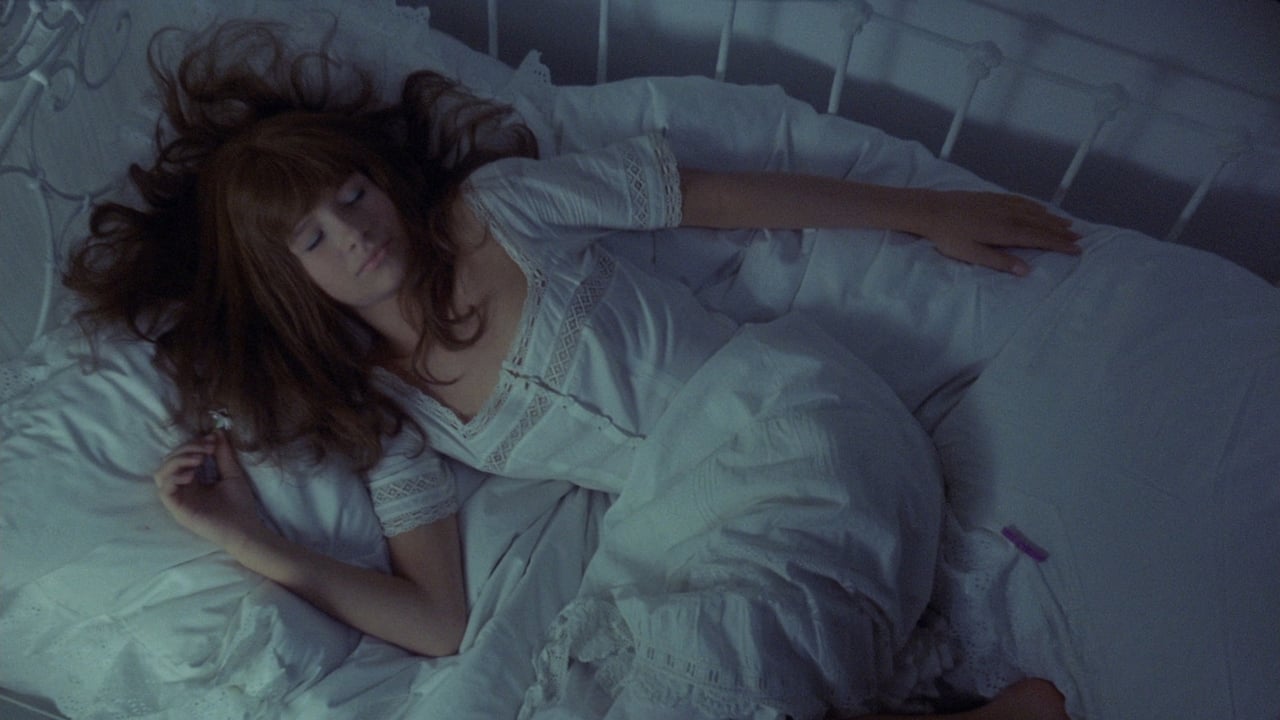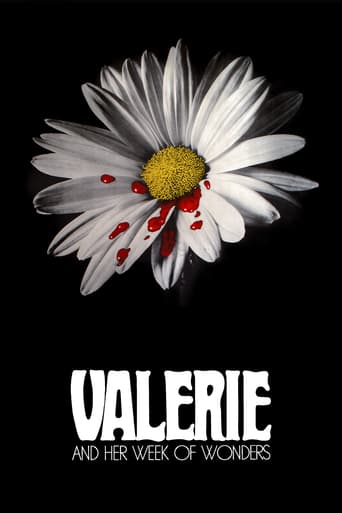

This extremely beautiful film was a latter day entry from the Czechoslovakian new wave. This cycle of highly personal films came out of the country during a period of change and turmoil, a fertile time for artists which was essentially curtailed after a clamp-down by the communist authorities. Interestingly Valerie and Her Week of Wonders was actually made and released in the early years of this regime. Quite surprising given the very artistic content, although having said that it is worth remembering that the legendarily creepy children's fantasy film The Singing Ringing Tree (1957) was produced in East Germany under another highly oppressive communist regime; so perhaps the communists had a blind spot when it came to bizarre cinematic fairy-tales. Whatever the case, both those productions benefited hugely from their central European ambiance. Valerie is a pretty singular bit of work though, and doesn't seem to borrow very much from anything else nor is there too much after it that is all that similar. The nearest equivalent from the Czechoslovakian new wave being the Gothic horror-melodrama Morgiana (1972) which also shares a dark fairy-tale aesthetic and highly stylized surrealist approach to its period-set material.The first thing you will notice straight from the get-go with this one is that it is a very visually beautiful film indeed. The photography and editing are exquisite, with many images that stay locked in the memory. Scenes of night-time menace combine with days of pastoral sunshine to create a world of well wonder, quite frankly. The story is quite elusive and not always clear but given that it compromises of dreams and the like this is quite understandable. Set some undisclosed time in the past, it focuses on a teenage girl called Valerie who lives with her grandmother. The story begins with her experiencing her first menstruation – beautifully indicated by a drop of blood falling on a daisy as she walks on by. Her subsequent sexual awakening coincides with the arrival of a carnival and from here many strange fantastical things occur including magic earrings, vampires, a predatory priest and a boy who sends her magical letters.Jaroslava Schallerová in the role of Valerie is a revelation. This young performer is thoroughly engaging as the innocent girl at the heart of events. It's definitely a pretty adult story for such a young performer to appear in, given the sexual nature and some of the disturbing scenes. But it is executed in a way that is true to the material without ever going too far. The story is essentially about her coming-of-age, told in the style of a dreamlike fantasy. The way things are told feels very true to its central European roots and events retain a very enigmatic feel, far removed from the narrative certainty the material would no doubt have had it been made in Hollywood. It's one of those films that it is really best just to dive into and not to worry so much about the reasons why and to simply embrace the feel of the thing. There are some aspects that seem to be making a more clear point, such as the criticism of organised religion, what with the character of the predatory priest and the witch-burning scene. But on the whole, this is more of a phantasmagorical, highly sensory experience. It is also quite unusual in its combination of fantasy with horror, of the latter there is the unforgettable character of Weasel who is a Nosferatu-like figure who navigates events with supreme malevolence sometimes while carrying a small pampered dog. Such unpredictability is par for the course here. It isn't a surrealist film per se but it certainly contains surreal elements punctuated throughout its run-time. Lubos Fiser and Jan Klusák add a considerable amount also with the haunting, organic score which complements the visuals really quite perfectly.Valerie and Her Week of Wonders is a heady concoction of true creativity. It makes you realise what cinematic invention truly is. It's one of those films which genuinely can be described as a one off master-work.
... View MoreIt is best not to attempt to "understand" this surreal masterpiece on an intellectual level. How can anyone comprehend the thoughts ,fantasies ,dreams and emotions of a young girl on the threshold of womanhood ? Instead ,I would suggest that you simply drift downstream with the movie ,allowing it to carry you where it may.Based on a Czech novel which seeks to examine Gothic themes in the light of Freudian psychology , it is most of all a visual feast in which every scene is a ravishingly beautiful composition. The dream-like quality is enhanced by the hauntingly atmospheric music and outstanding performances. Paramount among them is that of Jaroslava Schallerova as the titular character , even more astonishing when one remembers that she was only 14 at the time.Viewing "Valerie" is tinged with more than a little sadness when one considers that it was made shortly after the brutal crushing of the "Prague Spring " by the invading Soviet tanks. Tragic to think that the creative talents involved in this film would be destined to spend their careers stifled by Stalinist conformism.
... View MoreInspired by fairy-tales such as Alice in Wonderland and Little Red-Riding Hood, "Valerie and her Week of Wonders" is a surreal tale in which love, fear, sex and religion merge into one fantastic world: a disorienting dream, cajoled by priests, vampires, men and women alike, and blends elements of fantasy and horror films.Many writers have cited similarities between the film and the work of English writer Angela Carter, who had seen the film during its release in England. Her screenplay for "The Company of Wolves" (1984) adapted from Carter's short stories, in collaboration with director Neil Jordan, bears a direct or indirect influence.This connection is great, taking the surrealism of the Czech cinema and giving it a bit of a spin. "Wolves" is a bit more linear, a bit more straightforward. But the similarities are clear.
... View MoreJaromil Jires's decidedly dreamlike Czechoslovakian film Valerie and Her Week of Wonders, takes place in the countryside, as Valerie visits her relatives at their turn-of-the-century estate, only to find that they are vampires, engaging in a sort of ecstatic summer orgy into which Valerie will be initiated. Valerie and Her Week of Wonders is a deeply eccentric text, infusing a coming-of-age story with Edenic concepts of purity and lust, inclusion and banishment, into a sensuous tapestry in which nothing is as it seems.Written by Jires, Ester Krumbachova, and Vitezslav Nezval, the films brevity and its seductive mise-en-scene sumptuously photographed by Jan Curik, make the film seem almost an outlaw project, or an act of social criticism designed to "enforce atheism by embracing an anti-Catholic stance, particularly in relation to sexual morality. Yet the films embrace of sexual excess, and the almost fetishistic depiction of bodily fluids, color, light , flesh tones, and gauzy fabrics, bespeaks an atmosphere of absolute sexual license, rather than creating a fantasy world of repression. In many ways, Valerie is very much like Alice in Alice in Wonderland, reacting to the bizarre circumstances that unfold before her.The film begins with an image of Adam and Eve, and Valerie is often seen eating apples in close-up, her overripe lips lingering over the succulent fruit with undisguised satisfaction. Thus Valerie provides us with an image of feminine desire before and after the fall of Eden but without the attached blame that Eve shoulders in Western Christian mythology. Instead, Valerie is seen by the film as a giver of life, a force of purity too intense to be corrupted, while her grandmother becomes a vessel of corruption. This is a film that is deeply tied to nature at its most gloriously ripe season, summer, and Valerie herself partakes of this lushness with direct and unabashed delight.Valerie and Her Week of Wonders presents a world in which all is allegory, ones relatives may be vampires, and all authority figures are suspect; in the opening minutes of the film, a priest enters Valerie's dazzlingly white bedroom and almost immediately tries to rape her. Valerie extricates herself from the priest's attack but remains justly suspicious of authority for the rest of the film. What protects Valerie, above all other things, is her connection to nature, which preserves her position within the film as a force of hope within a crumbling family structure.In many ways Valerie and Her Week of Wonders can be read as a more sexually explicit vision of the coming-of-age narrative, centering on the freedom of youth, than its numerous American and British counterparts. Valerie emerges triumphant at the end of the film, despite all adult attempts to corrupt her, and the purity and innocence of her metaphoric quest is valorized by the film's ambiguous conclusion, in which all the films events are called into question; it may all have been a dream.
... View More